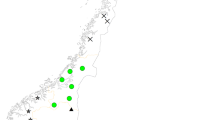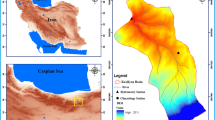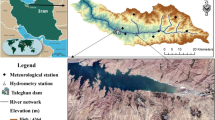Abstract
Most hydrological phenomena have stochastic behaviour; therefore, the theory of statistics and probability usually uses to describe and analyse them. Rainfall and runoff are two hydrological phenomena, described with different characteristics, e.g., volume, peak flow, and time base (runoff), and intensity, duration and depth (rainfall). In the current study, we used the copula functions for multivariate modelling of rainfall and runoff characteristics. To do this, the performance of 10 different copulas was examined in a multivariate analysis of rainfall and runoff characteristics measured in Kasilian basin located in northeastern Iran during a 37-yr period (1984–2020). The rainfall characteristics, including intensity, duration, and depth for 562 recorded rainfall events for the Kasilian basin at intervals of 15–30 min were extracted for rainfall–runoff analysis. Then, the rainfall histograms and flood hydrographs were drawn, and rainfall characteristics (i.e., depth, duration, and intensity) and runoff characteristics (i.e., peak discharge, peak discharge time, time base, flood volume, the width flood hydrograph at 50 and 75% of peak discharge (W50 and W75)) were extracted. In the next step, the univariate distributions with best fitness on every studied rainfall and runoff characteristics were determined. The results demonstrated that the GEV has the best fitness on all studied rainfall and runoff characteristics. Also, the Joe copula had the best fitness for joining the duration and depth of rainfall, as well as the intensity and depth of rainfall, and the Gumbel–Barnett and Farlie–Gumbel–Morgenstern were in the following ranks. Then the multivariate probability and return period were computed in two states of ‘AND’ and ‘OR’. It was demonstrated that in the ‘AND’ mode, the joint return period for a rainfall depth of 60 mm and rainfall intensity of 60 mm/h is less than 20 years, while for the same rainfall depth and intensity values, in the ‘OR’ mode, the joint return period is obtained about 6 years.
Research Highlights
-
Multivariate probabilistic rainfall–runoff model created using copula functions.
-
The GEV distribution had the best fitness on all studied rainfall and runoff characteristics.
-
The Joe copula had the best fitness for joining the duration and depth of rainfall, as well as the intensity and depth of rainfall.
-
The difference between standard return periods and Kendall return periods increases with increasing the probability level.











Similar content being viewed by others
References
Abdi A, Hassanzadeh Y, Talatahari S, Fakheri-Fard A and Mirabbasi R 2017 Parameter estimation of copula functions using an optimisation-based method; Theor. Appl. Climatol. 129(1) 21–32.
Abdollahi S, Akhoond-Ali A, Mirabbasi R and Adamowski J F 2019 Probabilistic event based rainfall-runoff modeling using copula functions; Water Resour. Manag. 33 3799–3814.
Akaike H 1974 A new look at statistical model identification; IEEE Trans. Automat. Contr. 19 716–723.
Amini S, Zare Bidaki R, Mirabbasi R and Shafaei M 2022a Flood risk analysis based on nested copula structure in Armand Basin, Iran; Acta Geophys. 70 1385–1399.
Amini S, Zare Bidaki R, Mirabbasi R and Shafaei M 2022b Multivariate analysis of flood characteristics in Armand Watershed, Iran using vine copulas; Arab. J. Geosci., https://doi.org/10.1007/s12517-022-11102-5.
Ayantobo O O, Li Y and Song S 2019 Copula-based trivariate drought frequency analysis approach in seven climatic sub-regions of mainland China over 1961–2013; Theor. Appl. Climatol. 137 2217–2237.
Bacchi B, Becciu G and Kottegoda N T 1994 Bivariate exponential model applied to intensities and durations of extreme rainfall; J. Hydrol. 155(1–2) 225–236.
Bezak N, Zabret K and Šraj M 2018 Application of copula functions for rainfall interception modelling; Water 10(8) 995.
Cherubini U, Luciano E and Vecchiato W 2004 Copula Methods in Finance; John Wiley & Sons Ltd., England, 310p.
Córdova J R and Rodríguez-Iturbe I 1985 On the probabilistic structure of storm surface runoff; Water Resour. Res. 21(5) 755–763.
De Michele C, Salvadori G, Canossi M, Petaccia A and Rosso R 2005 Bivariate statistical approach to check adequacy of dam spillway; J. Hydrol. Eng. 10(1) 50–57.
Dodangeh E, Shahedi K, Solaimani K, Shiau J T and Abraham J 2019 Data-based bivariate uncertainty assessment of extreme rainfall-runoff using copulas: Comparison between annual maximum series (AMS) and peaks over threshold (POT); Environ. Monit. Assess. 191(2) 67.
Dodangeh E, Singh V P, Pham B T, Yin J, Yang G and Mosavi A 2020 Flood frequency analysis of interconnected rivers by copulas; Water Resour. Manag. 34(11) 3533–3549.
Dupuis D J 2007 Using copulas in hydrology: Benefits, cautions, and issues; J. Hydrol. Eng. 12(4) 381–393.
Genest C, Rumillard B and Beaudoin D 2009 Goodness-of-fit tests for copulas: A review and a power study; Insur.: Math. Econ. 44(2) 199–213.
Goel N K, Kurothe R S, Mathur B S and Vogel R M 2000 A derived flood frequency distribution for correlated rainfall intensity and duration; J. Hydrol. 228(1–2) 56–67.
Jahannemaei N, Khosravinia P, Sanikhani H and Mirabbasi R 2022 Toward analysing meteorological droughts in the west of Iran: A multivariate approach based on vine copulas; Nat. Hazards, https://doi.org/10.1007/s11069-022-05747-4.
Kao S C and Govindaraju R S 2007 Probabilistic structure of storm surface runoff considering the dependence between average intensity and storm duration of rainfall events; Water Resour. Res. 43 W06410, https://doi.org/10.1029/2006WR005564.
Kojadinovic I and Yan J 2010 Modeling multivariate distributions with continuous margins using the copula R Package; J. Stat. Softw. 34(9) 1–20.
Kurothe R S, Goel N K and Mathur B S 1997 Derived flood frequency distribution for negatively correlated rainfall intensity and duration; Water Resour. Res. 33(9) 2103–2107.
Li H, Wang D, Singh V P, Wang Y, Wu J, Wu J, Liu J, Zou Y, He R and Zhang J 2019 Non-stationary frequency analysis of annual extreme rainfall volume and intensity using Archimedean copulas: A case study in eastern China; J. Hydrol. 571(1) 114–131.
Maeng S J, Azam M, Kim H S and Hwang J H 2017 Analysis of changes in spatio-temporal patterns of drought across South Korea; Water 9 679.
Nash J E and Sutcliffe J V 1970 River flow forecasting through conceptual models – A discussion of principles; J. Hydrol. 10 282–290.
Nelsen R B 2006 An Introduction to Copulas; Springer, New York, 269p.
Pandey P K, Das L, Jhajharia D and Pandey V 2018 Modelling of interdependence between rainfall and temperature using copula; Model Earth Syst. Environ. 4 867–879.
Poulin A, Huard D, Favre A C and Pugin S 2007 Importance of tail dependence in bivariate frequency analysis; J. Hydrol. Eng. 12(4) 394–403.
Ramezani Y, Nazeri Tahroudi M, De Michele C and Mirabbasi R 2023 Application of copula-based and ARCH-based models in storm prediction; Theor. Appl. Climatol., https://doi.org/10.1007/s00704-022-04333-9.
Requena A I, Mediero L and Garrote L A 2013 Bivariate return period based on copulas for hydrologic dam design: Accounting for reservoir routing in risk estimation; Hydrol. Earth Syst. Sci. 17 3023–3038.
Rizwan M, Guo S, Yin J and Xiong F 2019 Deriving design flood hydrographs based on copula function: A case study in Pakistan; Water 11(8) 1531.
Sadeghfam S, Mirahmadi R, Khatibi R, Mirabbasi R and Nadiri A A 2022 Investigating meteorological/groundwater droughts by copula to study anthropogenic impacts; Sci. Rep. 12 8285, https://doi.org/10.1038/s41598-022-11768-7.
Salvadori G and De Michele C 2010 Multivariate multi parameter extreme value models and return periods: A copula approach; Water Resour. Res. 46 W10501, https://doi.org/10.1029/2009WR009040.
Salvadori G, De Michele C, Kottegoda N T and Rosso R 2007 Extremes in Nature: An Approach Using Copulas; Water Science and Technology Library, 56, Springer, Netherland, 292p.
Shiau J T 2006 Fitting drought duration and severity with two-dimensional copulas; Water Resour. Manag. 20 795–815.
Singh K and Singh V P 1991 Derivation of bivariate probability density functions with exponential marginal; Stoch. Hydrol. Hydraul. 5(1) 55–68.
Sklar A 1959 Fonctions de répartition àn dimensions et leurs marges; Publications de L’Institut de Statistique de L’Université de Paris 8 229–231.
Tootoonchi F, Haerter J O, Räty O, Grabs T, Sadegh M and Teutschbein C 2020 Copulas for hydroclimatic applications – A practical note on common misconceptions and pitfalls; Hydrol. Earth Syst. Sci. Discuss., https://doi.org/10.5194/hess-2020-306.
Wen Y, Yang A, Kong X and Su Y 2022 A Bayesian-model-averaging copula method for bivariate hydrologic correlation analysis; Front. Environ. Sci. 9 744462, https://doi.org/10.3389/fenvs.2021.744462.
Xu C, Yin J, Guo S, Liu Z and Hong X 2016 Deriving design flood hydrograph based on conditional distribution: A case study of Danjiangkou Reservoir in Hanjiang Basin; Math. Probl. Eng., https://doi.org/10.1155/2016/4319646.
Yazdandoost F, Zakipour M and Izadi A 2021 Copula based post-processing for improving the NMME precipitation forecasts; Heliyon 7(9) e07877.
Yin J, Gentine P, Zhou S, Sullivan S C, Wang R, Zhang Y and Guo S 2018a Large increase in global storm runoff extremes driven by climate and anthropogenic changes; Nat. Commun. 9(1) 1–10.
Yin J, Guo S, He S, Guo J, Hong X and Liu Z 2018b A copula-based analysis of projected climate changes to bivariate flood quantiles; J. Hydrol. 566 23–42.
Yu J, Kim J E, Lee J H and Kim T W 2021 Development of a PCA-based vulnerability and copula-based hazard analysis for assessing regional drought risk; KSCE J. Civ. Eng. 25(5) 1901–1908.
Yue S 2001 A bivariate extreme value distribution applied to flood frequency analysis; Nord. Hydrol. 32 49–64.
Yue S and Rasmussen P 2002 Bivariate frequency analysis: Discussion of some useful concepts in hydrological applications; Hydrol. Process. 16 2881–2898.
Zhang L and Singh V P 2007 Bivariate rainfall frequency distributions using Archimedean copulas; J. Hydrol. 332(1–2) 93–109.
Zhang B, Wang S and Wang Y 2019 Copula-based convection-permitting projections of future changes in multivariate drought characteristics; J. Geophys. Res. Atmos. 124(14) 7460–7483, https://doi.org/10.1029/2019JD030686.
Zhao C, Brissette F, Chen J and Martel J L 2020 Frequency change of future extreme summer meteorological and hydrological droughts over North America; J. Hydrol. 584 124316, https://doi.org/10.1016/j.jhydrol.2019.124316.
Author information
Authors and Affiliations
Contributions
The participation of S Moradzadeh Rahmatabadi and M Irandoust was collecting the required data, model running and preparing the draft, and the participation of R Mirabbasi included writing the codes, analysis of results, and reviewing and editing the manuscript.
Corresponding author
Additional information
Communicated by P A Francis
Rights and permissions
About this article
Cite this article
Moradzadeh Rahmatabadi, S., Irandoust, M. & Mirabbasi, R. Multivariate analysis of rainfall–runoff characteristics using copulas. J Earth Syst Sci 132, 93 (2023). https://doi.org/10.1007/s12040-023-02105-1
Received:
Revised:
Accepted:
Published:
DOI: https://doi.org/10.1007/s12040-023-02105-1




